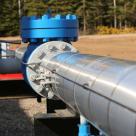NYMEX Gasoline futures closed down two cents at $2.62/Gal today. The NYMEX gasoline contract is now down 23 percent since the middle of March. Refiners on the East Coast are heading for the exits. Will gasoline demand recover this Summer? In today’s blog “No Apparent Demand – US Gasoline Thirst Evaporates” we take a closer look at the fundamentals.
Daily Energy Blog
NYMEX natural gas closed up again today at $2.767. Its now 26 percent higher than it was two weeks ago. Will recovering prices be reflected in higher sales this quarter? Today in “Uptown Top Ranking” we look at 1Q2012 NGI natural gas marketer rankings to see who is riding high in the charts so far this year and what the rankings mean to the market.
Last week the price of ethylene dropped from the low 50s per pound down to the low 40s. In a big flip-flop, propane has been the preferred feedstock for petrochemical plants on the Gulf Coast for a couple of weeks now (it had been ethane for the most part of the last 3+ years). And the petchem market hit ethane where it hurts, whacking the price down to 29.875 cnts/gal on Friday according to OPIS. A month ago that price was 50 cnts/gal. In October of last year the price was almost $1.00 (see graph below). This is good news for petchems, right? Well, it all depends on the margin that the petchem realizes on the feedstocks that are run. So to figure that out, let’s get to Part III of our series on the economics of petrochemical feedstocks.
The demand for motor gasoline is declining. The volume of ethanol in the gasoline pool is increasing. That means the market needs less gasoline from refineries. Another One Bites the Dust is a common refrain heard in refining circles – referring to the latest refinery shutdown. This week I caught the most succinct explanation of what is going on from Lynn Westfall, EVP of Turner, Mason & Co. out of Dallas. He was speaking at the Platt’s North American Refining & Trading Conference held on Monday and Tuesday of this week. The following are my notes (and color commentary) from Lynn’s presentation. We’ll start with two of his most compelling charts.
Sometimes learning is about getting your mind changed. Over the past couple of days at Bentek’s Benposium conference in Houston there were a lot of presentations and powerpoint slides looking at all sides of the LNG export issue. I’m still not convinced that we’ll see more than one terminal built in the U.S. But I was convinced of three things: (a) there is a need for LNG exports to balance oversupply in the natural gas market, (b) pricing differentials support the economics necessary to build these facilities, and (c) if even a couple of the liquefaction plants and terminals are built, it will have a big impact on the natural gas market in North America.
Yesterday was Day#2 of Benposium, the annual Bentek conference being held at the Houstonian hotel in Houston. It was another day when I could attend the sessions as a participant, which is considerably harder work than it sounds. Between Tuesday and Wednesday there were seven outside speakers and 15 breakout sessions with Bentek analysts, each repeated twice over the two days. They went deep into natural gas, crude oil and NGL markets. After 48 hours of Benpo 2012, my brain is full. And there is one more day to go.
Rather than getting into the gory details of all these presentations, I thought it would be a good idea to take a page out of Cramer (that would be Cramer's Mad Money, not Cosmo Kramer) and do a lightning round on all of the major themes I heard across the two days.
Yesterday ICE next-day gas at Henry Hub posted at $1.85/MMbtu, down a penny from Wednesday. The CME/Nymex May contract settled at still another 10 year low (how many more 10 year lows could there be?) at $1.907, down 4.4 cnts. But May WTI crude oil at Cushing is still above one hundred bucks a barrel, closing at $102.27/bbl, off 40 cnts. Our favorite measure of fundamental market disparity – the ratio of prompt crude futures to cash gas is now up to 55X (simply 102.27/1.85).
Yesterday I attended and was a speaker at the Platts 6th Annual Rockies Oil & Gas conference at the Grand Hyatt Denver. There were about 350 registered attendees, by far the largest of these conferences. I’ve been a speaker at the event for the past four years. Good friend and master of ceremonies Stuart Nance (his first day on the job as VP of Bill Barrett Corp.) noted that in previous years the conference was titled Gas and Oil Conference. Now the order is reversed. That tells you a lot about the speaker topics and audience interest. I spoke at 2:15 and was the first to utter the word “gas”. And I only had 3 slides on the topic.
Yesterday the folks at RBC Capital Markets issued an excellent research piece titled “Cross-Sector Implications of North America Energy Supply Chain Evolution.” It is a look at the shale revolution from the perspective of a supply chain – the linkages between interconnected businesses involved in the development, extraction and production of liquid and gas hydrocarbon energy. The 31 page report makes some great points about the fundamentals of today’s hydrocarbon markets and recommends stocks that are expected to benefit from these developments. I thought it would be useful to summarize the high points of their investment thesis here. You’ll need to contact RBC if you want to see the report and its investment strategies.
Crude oil production in the Eagle Ford has ramped up from less than 50 Mb/d two years ago to almost 400 Mb/d today, and the growth shows no sign of slowing down. In most reports and statistics, all of this volume shows up as crude oil. But it’s not. Between 60%-70% of this production is condensate – a hydrocarbon classification that is somewhere between crude oil and natural gas liquids. It is valued differently from crude, can require handling different from crude, and can go into markets different from crude. But neither is it a natural gas liquid. Condensates are produced in the field, not extracted from a wet gas stream by a cryogenic processing unit. Condensates are neither fish nor fowl.
Just after 2pm eastern time on Monday, the CME/NYMEX (GLOBEX) markets for U.S. crude, gasoline and heating oil futures shut down. Data feeds to trading terminals ceased. The timing was bad. It was a half-hour before the close. Brokers that have been jacked into their terminals for six years (since the launch of “parallel electronic trading”) rushed to the usually comatose oil-futures pit to execute orders that couldn't be completed electronically. Humans traded with humans. (“It’s Alive!”) Thinking about how this must have played out, I just can’t get the final scene of Surrogates, the 2009 Bruce Willis movie out of my head. All those traders in their pajamas walking dazed into the pit.
“Prices have dropped to the lowest level in years. Pipelines are overbooked, and supplies are backing up. There is just not enough capacity to get out of the supply area and into the market area. Pipeline capacity is at a premium. The last time prices got to this level, producers shut in.”
It looks like OPEC has started to figure out that this shale thing might be a problem for them. The evidence? In the latest edition of OPECs bi-monthly bulletin, there is an article about the environmental risks of shale gas drilling in the north of England. OPEC? Environmental risk? Hmmm.
Yesterday Feb. natgas was up 10.3 cents at $3.096/MMBtu. Don’t get excited. This is just a minor blip due to weather and a little bit of crude sympathy. There is still a lot of gas out there.















